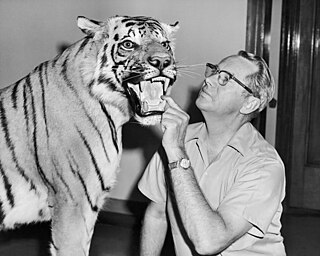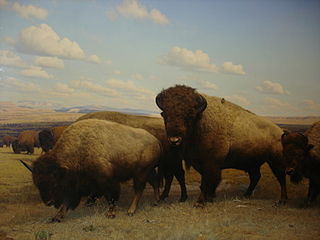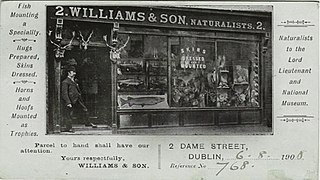 W
WTaxidermy is the art of preserving an animal's body via mounting or stuffing, for the purpose of display or study. Animals are often, but not always, portrayed in a lifelike state. The word taxidermy describes the process of preserving the animal, but the word is also used to describe the end product, which are called taxidermy mounts or referred to simply as "taxidermy".
 W
WBarry der Menschenretter (1800–1814), also known as Barry, was a dog of a breed which was later called the St. Bernard that worked as a mountain rescue dog in Switzerland and Italy for the Great St Bernard Hospice. He predates the modern St. Bernard, and was lighter built than the modern breed. He has been described as the most famous St. Bernard, as he was credited with saving more than 40 lives during his lifetime, hence his byname Menschenretter meaning "people rescuer" in German.
 W
WBird collections are curated repositories of scientific specimens consisting of birds and their parts. They are a research resource for ornithology, the science of birds, and for other scientific disciplines in which information about birds is useful. These collections are archives of avian diversity and serve the diverse needs of scientific researchers, artists, and educators. Collections may include a variety of preparation types emphasizing preservation of feathers, skeletons, soft tissues, or (increasingly) some combination thereof. Modern collections range in size from small teaching collections, such as one might find at a nature reserve visitor center or small college, to large research collections of the world's major natural history museums, the largest of which contain hundreds of thousands of specimens. Bird collections function much like libraries, with specimens arranged in drawers and cabinets in taxonomic order, curated by scientists who oversee the maintenance, use, and growth of collections and make them available for study through visits or loans.
 W
WThe conservation of taxidermy is the ongoing maintenance and preservation of zoological specimens that have been mounted or stuffed for display and study. Taxidermy specimens contain a variety of organic materials, such as fur, bone, feathers, skin, and wood, as well as inorganic materials, such as burlap, glass, and foam. Due to their composite nature, taxidermy specimens require special care and conservation treatments for the different materials.
 W
WCount Noble was a male Llewellin Setter. He was so well known that when he died in 1891, The New York Times ran an obituary. He was popularly known as the "$10,000 hunting dog." He was described as a "national symbol of what was great in bird dogs."
 W
WDuring the 20th century, Deyrolle was a Parisian institution for natural sciences and pedagogy. It is one of the best known companies of entomology and taxidermy of Paris. Today, Deyrolle is a shop and a cabinet of curiosities open to the public, a reference in the field of taxidermy, entomology and natural sciences, whose vocation is to show the beauty of Nature. Deyrolle is also involved in pedagogy and art.
 W
WThe Fiji mermaid was an object composed of the torso and head of a juvenile monkey sewn to the back half of a fish. It was a common feature of sideshows where it was presented as the mummified body of a creature that was supposedly half mammal and half fish, a version of a mermaid. The original had fish scales with animal hair superimposed on its body with pendulous breasts on its chest. The mouth was wide open with its teeth bared. The right hand was against the right cheek, and the left tucked under its lower left jaw. This mermaid was supposedly caught near the Fiji Islands in the South Pacific. Several replicas and variations have also been made and exhibited under similar names and pretexts. P. T. Barnum exhibited the original in Barnum's American Museum in New York in 1842, but it then disappeared—likely destroyed in one of Barnum's many fires that destroyed his collections.
 W
WLion Attacking a Dromedary is an orientalist diorama by French taxidermist Édouard Verreaux in the collection of the Carnegie Museum of Natural History. It depicts a fictional scene of a man on a dromedary struggling to fend off an attack by a Barbary lion. The diorama was created for the Paris Exposition of 1867 and subsequently shown at the American Museum of Natural History, Centennial Exposition, and the Carnegie Museum of Natural History.
 W
WThe Lion of Gripsholm Castle is a notable example of bad taxidermy, in the museum of Gripsholm Castle, in Sweden. The lion is badly stuffed; and has a comically unrealistic face.
 W
WThe Physical Impossibility of Death in the Mind of Someone Living is an artwork created in 1991 by Damien Hirst, an English artist and a leading member of the "Young British Artists". It consists of a tiger shark preserved in formaldehyde in a vitrine. It was originally commissioned in 1991 by Charles Saatchi, who sold it in 2004 to Steven A. Cohen for an undisclosed amount, widely reported to have been at least $8 million. However, the title of Don Thompson's book, The $12 Million Stuffed Shark: The Curious Economics of Contemporary Art, suggests a higher figure.
 W
WRahmat International Wildlife Museum & Gallery is a natural history museum in Medan, Indonesia. The museum displays various collections of wildlife from the smallest to the largest according to the habitat. After the development was completed in October 2007, the Museum & Gallery has an area of 2970 m² building.
 W
WSinclair Nathaniel Clark was a legendary taxidermy tanner, known throughout that industry for his expertise in tanning animal skins to give them the suppleness that taxidermists require to create lifelike, long-lasting displays. Tanning is the process of treating animal skins and hides for display and preservation. Because tanning is a behind-the-scenes operation of taxidermy, tanners are seldom known outside the industry.
 W
WThe skvader is a Swedish fictional creature that was constructed in 1918 by the taxidermist Rudolf Granberg and is permanently displayed at the museum at Norra Berget in Sundsvall. It has the forequarters and hindlegs of a European hare, and the back, wings and tail of a female wood grouse. It was later jokingly given the Latin name Tetrao lepus pseudo-hybridus rarissimus L.
 W
WThe Southern white rhino ("Bull") is a famous conservation success story for his species. Southern white rhinos were thought to be extinct in the late 1800s until a small herd was discovered. Since then, rhinos like Bull have been part of various international breeding programs. As a result, their population is now close to 20,000, classifying them as Near Threatened and making them the only species of rhinoceros that is not endangered.
 W
WStoned Fox is an anthropomorphic taxidermied fox that has become an Internet sensation in Russia.
 W
WThe Torrington Gopher Hole Museum, located in Torrington, Alberta, features stuffed gophers posed to resemble townspeople. It was opened in 1996.
 W
WVan Ingen & Van Ingen, simply Van Ingen, or Van Ingen of Mysore (1900–1999) were Indian taxidermists located in Mysore, South India, best known for their tiger and leopard taxidermy trophy mounts. A History of Taxidermy. Art, science and bad taste states that Van Ingen factory processed more than 43,000 tiger and leopard trophies in less than 90 years of operation. Van Ingen & Van Ingen taxidermy today are still found throughout the world in the form of head mounts, full mounts, flat animal rugs, and rug mounts with heads attached.
 W
WWilliams & Son, Dublin was a taxidermy firm which operated in Dublin, Ireland from the late 1860s to the early 1940s.